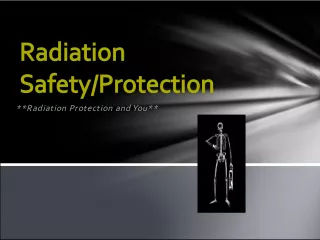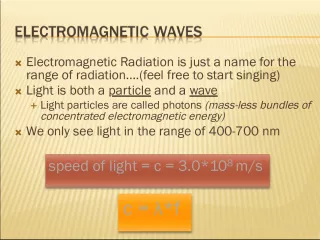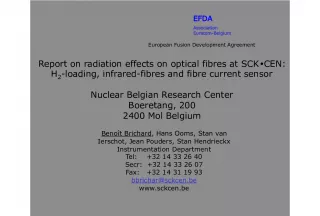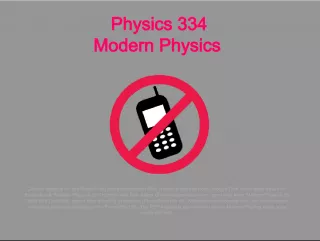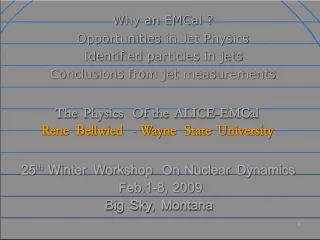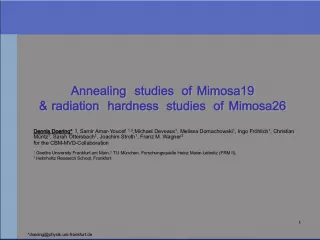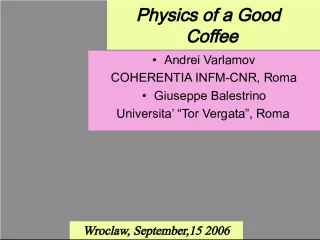Physics of Ionizing Radiation in Biomedical Engineering
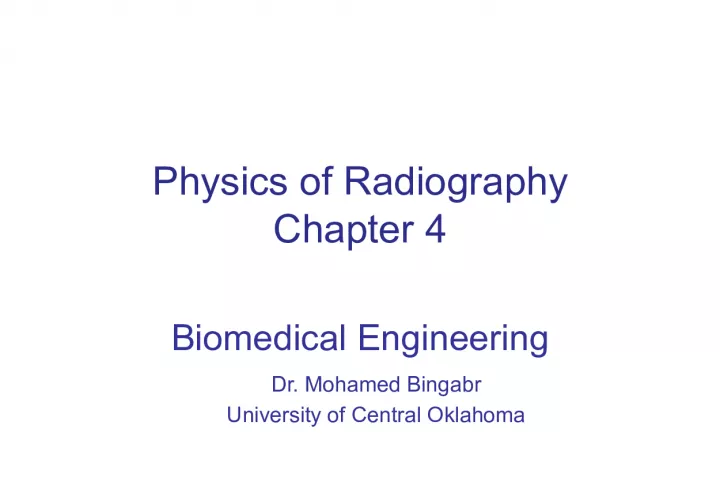

This chapter discusses the forms and properties of ionizing radiation, as well as its attenuation and dosimetry. It explains how different tissues and organs attenuate the beam of radiation, and how projection radiography and computed tomography use this property for anatomical imaging.
- Uploaded on | 3 Views
-
 lesliegreen
lesliegreen
About Physics of Ionizing Radiation in Biomedical Engineering
PowerPoint presentation about 'Physics of Ionizing Radiation in Biomedical Engineering'. This presentation describes the topic on This chapter discusses the forms and properties of ionizing radiation, as well as its attenuation and dosimetry. It explains how different tissues and organs attenuate the beam of radiation, and how projection radiography and computed tomography use this property for anatomical imaging.. The key topics included in this slideshow are ionizing radiation, projection radiography, computed tomography, attenuation, dosimetry,. Download this presentation absolutely free.
Presentation Transcript
1. Physics of Radiography Chapter 4 Biomedical Engineering Dr. Mohamed Bingabr University of Central Oklahoma
2. Outline Introduction Ionization Forms of Ionizing Radiation Nature and Properties of Ionizing Radiation Attenuation of Electromagnetic Radiation Radiation Dosimetry
3. Ionizing Radiation Forms of radiation : visible light, x-rays, gamma rays, electron beams. Ionizing radiation: Radiation capable of ejecting electrons from atoms. Projection radiography and computed tomography: depends on the transmission of ionizing radiation through the body. Different tissues and organs attenuate differently the intensity of the beam of ionizing radiation. Projection radiography and computed tomography are anatomical imaging modalities.
4. Figure II.1 Representative x-ray transmission images of various parts of the body: (a) hand, (b) head and neck, (c) knee, (d) chest, (e) feet, and (f) pelvis.
5. Figure II.2 X- ray images of (a) the spine shown a surgical fixation device, (b) the pelvis showing two artificial hip joints, and (c) the knee showing bone fixation wires.
6. CT removes overlaying structures by reconstructing cross sections of the body, image with low resolution, require higher x-ray dose to the patient. Figure II.3 Various CT images of the human body: (a) wrist, (b) torso and abdomen, (c) complete spine, (d) chest, and (e) ankle.
7. Forms of Ionization Radiation 1) X-ray Radiation Electromagnetic wave whose frequencies are much higher than those of visible light. 2) Particulate Radiation: electron beam 3) Gamma-rays Radiation: originated from the nucleus
8. Atomic Structure An Atom consists of nucleus of protons and neutrons surrounded by orbiting electrons. Protons and neutrons together are called nucleons . Proton has a positive charge and the magnitude equals the charge of the electron. Atomic number Z: equal the number of proton in the nucleus. Mass number A: the number of nucleons in the nucleus
9. Atomic Structure Nuclide refers to any unique combination of protons and neutrons forming a nucleus. Symbol for nuclide Example : Carbon Unstable nuclides are called radionuclides, and their atoms are radioactive. Beta particle
10. Atomic Structure The electron orbiting the nucleus are organized into orbits (shells K L M N). Electrons are restricted to specific quantum states within each shell. The maximum number of electrons per shell is given by 2 n 2 , where n is the shell number (K=1, N=4). Atom is in the ground state when electrons are in the lowest orbital shells and within the lowest energy quantum states within each shell.
11. Electron Binding Energy It is more favorable for an electron to be bound in an atom rather than to be free. Electron binding energy is specified in units of electron volts (eV). 1 eV is equal to the kinetic energy gained by an electron when accelerated across one volt potential. 1 eV = 1.6x10 -12 ergs = 1.6 x10 -19 J Binding energy facts: 1. depends on the element, 2. depends on the shell at which electron resides. 3. decreases with increasing shell number
12. Electron Binding Energy average binding energy is specified by the average binding energy of the electrons in a given atom. Average binding energy of Air = 34 eV Lead = 1 keV Tungsten = 4 keV Example : Suppose an electron is accelerated within a vacuum from a heated cathode held at ground potential to an anode held at 120 kV (DC). If the anode is made of tungsten, what is the maximum number of tungsten atoms that can be ionized on average?
13. Ionization and Excitation Ionization : If radiation (particulate or EM) transfers energy to an orbiting electron which is equal to or greater than that electrons binding energy, then the electron is ejected from the atom. The positive charged atom and the ejected electron are called an ion pair . Radiation with energy greater than 13.6 eV is considered ionizing. The ionization radiation used in medical imaging has energies ranging from 25 keV to 500 keV.
14. Ionization and Excitation Excitation : If the radiation energy is less than the binding energy of electron, then the electron is excited and raised to a higher energy state (to more outer orbit) but is not ejected. In both excitation and ionization, an electron shell is left with a hole that must be filled in order to return the atom to a lower energy. The filling of these holes comprises an important source of secondary radiation called characteristic radiation .
15. Forms of Ionizing Radiation Particulate (electron, proton, or neutron) Electromagnetic Particulate ionizing radiation Particles possess enough kinetic energy to ionize an atom. Particles involved in medical imaging are electrons, positrons, and alpha. In projection radiography we consider only electrons.
16. Particulate Ionizing Radiation Example Consider an electron that has been accelerated between a cathode and anode held at a 120 kV potential difference. Assume the situation is nonrelativistic. What is the speed of the electron when it slams into the anode? m 0 is the mass at rest, for electron it is 9.11x10 -31 kg. When v is small relative to c , the kinetic energy reduce to Kinetic Energy
17. Electromagnetic Ionizing Radiation EM radiation comprises an electric wave and a magnetic wave traveling together at right angles to each other. Examples : radio waves, microwaves, infrared light, visible light, ultraviolet light, x-rays, and gamma rays. - When EM radiation is conceptualized as packets of energy termed photons, then the energy is E=hv , where h = 6.626x10 -34 joules-sec is Planks constant and v is the frequency of radiation in Hz. - When EM radiation is considered as wave then its wavelength is =c/v
18. Electromagnetic Ionizing Radiation Gamma rays are created in the nuclei and x-rays are created in the electron clouds of atoms.
19. Nature and Properties of Ionizing Radiation The important effects of radiation in medical imaging are 1- forming images and affect the imaging process, 2- contribute to dose that has biological consequence.
20. Primary Energetic Electron Interactions The two main mechanisms by which Energetic electrons interact and transfer energy to an absorbing medium are collisional and radiative transfer. Radiative interaction produces x-ray used in medical imaging. 1) Collisional transfer (most common) Part of electrons energy goes to electron orbiting an atom of the medium. When the atom return to its original state it radiates infrared radiation Large part of electrons energy struck an electron in the medium causing it to be a new energetic electron which forms a new path of ionization ( delta ray ).
21. Radiative Transfer of Energetic Electron 2) Radiative transfer The energetic electrons interaction with an atom produces Characteristic or Bremsstrahlung x-rays. - Characteristic radiation Incident electron collide with electron in the K shell and create an ion pair. When atom return to ground state it radiate characteristic x-ray. - Bremsstrahlung radiation as the electron attracted to the positive nucleus it decelerates and lose energy in the form of an EM photon. Radiation increases with incident electrons energy and the atomic number of the atom.
22. X-ray Tube Bremsstrahlung radiation is the primary source of x- rays from an x-ray tube. When accelerated electrons in x-ray tube strike the tungsten anode (target), they lose energy by both collisional and radiative transfer; so heat, characteristic x-rays, and bremsstrahlung x-ray are produced. Figure 4.5 When energetic electrons bombard a target, two kinds of x-rays are produced: characteristic x- rays and bremsstrahlung x- rays. Low-energy x-rays of both types are absorbed by the medium. K: 69.5 keV L: 12 keV M: 3 keV
23. Primary Electromagnetic Radiation Interactions The three main mechanisms by which EM ionizing radiation interacts with materials to from images are: 1. The photoelectric effect - Incident x-ray photon totally loss energy to the atoms electron cloud. - Provide contrast between different types of tissues in the medical image. 2. Compton scatter - Incident x-ray photon partially loss energy to the atoms electron cloud and change direction. - Limit the resolution of x-ray images. 3. Pair production (need high energy 1.02 MeV so it isnt applicable in medical imaging 25 - 500 keV).
24. Primary Electromagnetic Radiation Interactions Figure 4.6 The photoelectric effect, shown in (a) and (b), and Compton scattering, shown in (c).
25. EM Photoelectric Effect
26. Compton Scattering The kinetic energy of the Compton electron is
27. Example Compton scattering is usually undesirable in medical imaging. In planar scintigraphy (Chapter 8), the energy of a photon is used to determine whether it has been scattered prior to arrival at the detector. Suppose a photon with energy hv = 100 keV is incident to some material and exits with energy hv . A detector decides that the photon has not been scattered if hv > 98 keV. What is the maximum angle by which the photon is scattered but is still being treated as a photon traveling along a straight path?
28. Probability of EM Interactions
29. Probability of EM Interactions
30. Tables
31. Relative Frequency of Occurrence Relative frequency of occurrence of photoelectric and Compton events Photoelectric events deposit all of their incident photon energy, while Compton events deposit only a fraction of their incident photon energy
32. Attenuation of Electromagnetic Radiation Attenuation is the process describing the loss of strength of a beam of EM radiation. Tissue-dependent attenuation ( ) is the primary mechanism by which contrast is created in radiography modalities.
33. Measures of X-ray Beam Strength Photon fluence : the number of photons N per unit area A . Reasons to measure the x-ray burst (beam) Characterize the inherent noise in the system Adjust the dynamic range of the detection system Estimating the biological effects of ionizing radiation. Area is oriented at a right angle to the direction of the radiation beam propagation. Photon fluence rate: the number of photons per unit area per unit time
34. Energy for Monoenergetic X-ray Beam Energy fluence : Energy fluence rate : Energy fluence rate is also defined as Intensity I For monoenergetic beam the energy fluence is Unit of I is energy per unit area per unit time. Where E = hv
35. Energy for Polyenergetic x-ray Beam Each x-ray photon carries its own discrete energy. - A line spectrum is a plot of N as a function of E . - The line spectrum changes with each photon burst. - The line density (number of photons per unit energy as a function of E ) remain constant for a given source. - The x-ray spectrum S ( E ) is the line density per unit area per unit time.
36. Energy for Polyenergetic x-ray Beam Intensity of polyenergetic x-ray Photon fluence rate
37. Example It is often desirable to model a polyenergetic x-ray beam as a monoenergetic source. What energy would a (hypothetical) monoenergetic source have to be in order to produce the same intensity as the (true) polyenergetic source using the same number of photons? Note : This energy is called the effective energy of a polyenergetic source.
38. Narrow Beam, Monoenergetic Photons Linear attenuation coefficient for homogeneous slab. Define N = N N= -n Fundamental photon attenuation law where N 0 is the number of photons at x = 0 is the fraction of photons that are lost per unit length.
39. Half Value Layer (HVL) The fundamental photon attenuation law in term of Intensity is Half Value Layer (HVL) I 0 is the intensity of the incident beam. The thickness of a given material that attenuate half of the incident photons.
40. Narrow Beam, Monoenergetic Photons Heterogeneous Slab For heterogeneous slab, the linear attenuation coefficient depends on the position x. Example: 140 keV gamma rays are generated by the radioactive decay of technetium-99m, and that sodium iodide crystals are used to detect such gamma rays. Assume that the HVL of sodium iodide at 140 keV is 0.3 cm. What percentage of gamma rays will pass right through a 1.2 cm sodium iodide crystal?
41. Narrow Beam, Polyenergetic Photons In general, the linear attenuation coefficient is different for different material, and it also varies as a function of energy for the same material.
42. Narrow Beam, Polyenergetic Photons For a homogeneous slab of material of thickness x with an incident x-ray beam having spectrum S 0 ( E ), the spectrum leaving the slab is For a heterogeneous slab of material, the linear attenuation depends on both position and energy.
43. Broad Beam Case In broad beam case, more photons are generally detected than is predicted by a monoenergetic, narrow beam analysis. Most x-ray imaging modalities use detector collimation, which reduced the number of x-rays from nonnormal directions that can hit the detectors. Therefore, from an imaging stand point, the narrow beam geometry assumption can be viewed as fairly accurate.
44. Radiation Dosimetry The study of the a mound of radiation that produces adverse biological effects. Exposure ( X ) The number of ion pairs produced in a specific volume of air by EM radiation (coulombs per kilogram of air). In medical imaging the unit is Roentgen (R = 2.58x10 -4 C/kg). Example: For a point source of radiation, the exposure at a distance d from the source follows an inverse square law. If the exposure at d = 30 cm from a point source is 1 R, what is the exposure at d = 5 cm from the source?
45. Radiation Dosimetry Rad (unit for Dose ) The unit of absorbed dose (energy-deposition concentration) absorption of 100 ergs per gram of material. The SI unit for absorbed dose is Gray (Gy). 1 Gy = 1 J/kg = 100 rads. Kerma ( K ) Measure of the amount of energy per unit mass imparted directly to the electrons in a given material. Specific ionization (SI) The number of ion pairs formed per unit length. Linear Energy Transfer (LET) Measure of the energy transferred by radiation to the material through which it is passing per unit length.
46. The f -Factor ( f ) The f -Factor ( f ) Determine the relationship between exposure ( X ) and the dose ( D ) to individual in the radiation field. For air 1 R = 0.87 rad. For other material D = f X where f is is the linear attenuation coefficient and is the mass density, and / is the mass attenuation coefficient.
47. Mass Attenuation Coefficient
48. Dose Equivalent ( H ) Dose Equivalent ( H ) Different types of radiation when delivering the same dose, can actually have different effects on the body. Where Q is the quality factor of the radiation. For x-rays, gamma rays, electrons, and beta particle Q 1 For neutrons and protons Q 10 For alpha particles Q 20 H = DQ the unit is rems Example Consider a chest x-ray at an energy of 20 keV. For simplicity ignore all tissues except the lung. If we want to keep the absorbed dose below 10 mrads what should be the limit on the exposure?
49. Effective Dose Effective dose is obtained as the sum of dose equivalents to different organs or body tissues weighted in such a fashion as to provide a value proportional to radiation-induced somatic and genetic risk even when the body is not uniformly irradiated. With effective dose, risks may be compared for different radiations and different target tissues. Natural annual individual effective dose = 300 mrem Chest x-ray = 3 - 4 mrem Fluorscopic study = several rem

